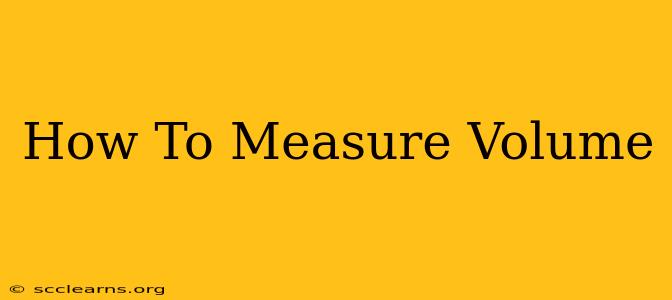Measuring volume, the amount of three-dimensional space occupied by a substance or object, is a fundamental skill in various fields, from cooking and construction to science and engineering. Understanding the different methods and units of measurement is crucial for accurate results. This comprehensive guide will walk you through various techniques for measuring volume, catering to different needs and situations.
Understanding Units of Volume
Before delving into the methods, it's essential to understand the common units used to measure volume:
- Cubic Meters (m³): The standard unit in the International System of Units (SI). One cubic meter is the volume of a cube with sides of one meter each.
- Liters (L): A common unit for liquid volume. One liter is equal to one cubic decimeter (0.001 m³).
- Milliliters (mL): A smaller unit frequently used for smaller volumes of liquids. One liter equals 1000 milliliters.
- Cubic Centimeters (cm³): Often used for smaller volumes, one cubic centimeter is equal to one milliliter.
- Gallons (gal), Quarts (qt), Pints (pt), Cups (c), Ounces (oz): These are common units in the US customary system. Conversion factors are readily available online or in conversion charts.
- Cubic Feet (ft³), Cubic Inches (in³): Other units in the US customary system used for larger volumes.
Methods for Measuring Volume
The method you choose to measure volume depends heavily on the nature of the substance and the accuracy required.
1. Measuring the Volume of Regular Solids
For objects with regular shapes like cubes, rectangular prisms, cylinders, and spheres, calculating volume is straightforward using geometric formulas:
- Cube: Volume = side³
- Rectangular Prism: Volume = length × width × height
- Cylinder: Volume = π × radius² × height
- Sphere: Volume = (4/3) × π × radius³
Example: To find the volume of a rectangular box that measures 10cm long, 5cm wide, and 2cm high, simply multiply the dimensions: 10cm × 5cm × 2cm = 100 cm³
2. Measuring the Volume of Irregular Solids
Measuring the volume of irregularly shaped objects requires a different approach. The most common method is water displacement.
Water Displacement Method:
- Fill a graduated cylinder or other container with a known volume of water. Record this initial volume.
- Carefully submerge the irregular object completely in the water. Ensure no air bubbles are trapped.
- Record the new water level.
- Subtract the initial water volume from the final water level. The difference represents the volume of the irregular object.
Important Note: This method works best for objects that don't absorb water. For objects that do absorb water, alternative methods like using a liquid that doesn't cause absorption might be necessary.
3. Measuring the Volume of Liquids
Measuring the volume of liquids is usually done with graduated cylinders, beakers, measuring cups, or other calibrated containers. Always ensure the container is placed on a level surface and read the volume at eye level, at the bottom of the meniscus (the curved surface of the liquid).
4. Using Digital Volume Measurement Tools
Modern technology offers sophisticated tools for measuring volume. These can include:
- Digital volumetric measuring devices: These offer high precision and ease of use.
- 3D scanners: These can create a digital model of an object and calculate its volume with high accuracy.
Tips for Accurate Volume Measurement
- Choose the right tool: Select the measuring device appropriate for the size and shape of the object and the required level of accuracy.
- Minimize errors: Be careful to avoid parallax errors when reading measurements. Read the measurement from the correct angle.
- Use appropriate units: Always specify the units of measurement to avoid ambiguity.
- Check for calibration: Regularly check the calibration of your measuring instruments to ensure accuracy.
By understanding these methods and following these tips, you can accurately measure volume in various contexts. Remember to choose the method best suited to the object or substance you're measuring. Accurate volume measurement is essential for many tasks, and mastering these techniques will improve your precision and efficiency.

